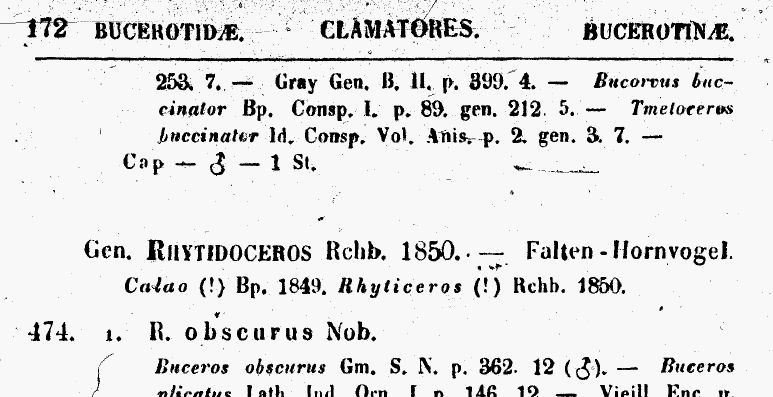
"Although Jacquinot's name appears on the subtitle page, a statement in the introduction (obviously by Pucheran although unsigned) announces that neither Hombron nor Jacquinot is to be held responsible for errors in the nomeclature adopted in the succeeding text for which he (Pucheran) is alone to blame. It is evident that Pucheran must be quoted as author of the ornithology and mammalogy."
Genus
Genus
Eupsittula Bonaparte, 1853, Compt. Rend. Ac. Sci. Paris 37: 807.
Type, by monotypy, Psittacus petzii Leiblein = P. canicularis Linnaeus.
"25. December 1892"
So the imprint date of "October" is demonstrated to be incorrect.Issued Ap.3/93
Orycerca everetti.
We have here: erihthachorides (p. 283) / erithachorides (p. 979) Baird, 1858. The name was explicitely established in connection with the cited pre-Linnean Chloris erithachorides, indicating that "erihthachorides" was an inadvertent error. Lowery & Monroe (1968: 20) cited "erihtachorides (sic)", and used erithachorides, the correct original spelling. Dendroica erithachorides = Dendroica petechia erithachorides [Dickinson, 2003: 761]. In fact, two original spellings in the same work. A First Reviser is needed, but the one choice open to him is erithachorides on account of the internal information.
2020.05.31

Buteo elegans Cassin, 1856, Proc. Acad. Nat. Sci. Philadel- phia, 7(1855), p.281.
New name for the Asio leucotis leucotis of Erlanger (J.f.O., 1904, 233, pl. XIX, low. fig.), nec Temm. Erlanger renamed the northern instead of the southern form.
Emended to erythrina.Though no additional data or rationale is given in support of this. Nor is there discussion of the validity of the "emendation".
The emended name used here is judged to be in prevailing usage: see Art. 33.2 of the Code (I.C.Z.N., 1999)(1178) and p.828.p.828 lists the use of erythrina in Cat.BirdsBr.Mus. and in Peters Checklist. The Cat.BirdsBr.Mus. is evidently in vol.IX p.140.
1921 Pratt, T.K., 1983. Additions to the avifauna of the Adelbert Range. Papua New Guinea. — Emu, 82(3):117-125 (1982).
contents page for the volume dates the issues and this issue is dated 24 Nov. 1982so the mystery is solved. I am thankful for his communication of 2006.06.01 explaining this.
The specimens in Beccardi's collection from Mount Singalan, W. Sumatra (S. etorques, Salvad.), were most probably not fully adult birds.
*A copy of this paper, proposing a new name, was sent to Dr. M. Louette in October 1980, shortly after it had been submitted for publication. Dr. Louette has since seen fit to describe the new honeyguide without informing us of his intention (Louette 1981, a new species of honeyguide from West Africa, Rev.Zool.Afr. 95:131-135 --Melignomon eisentrauti). His paper came to hand while this one was in proof and it has been possible to do little more than delete the proposed name and substitute eisentrauti for it in the text and table.
~~~~~~~~~~~~~~~~~~~~~~~~~~~~~~~~~~~~~~~
[Cacatua] Eleonora Finsch 1863.
Nederl. Tijdschrift. Dierkunde, I, Afd.? 1863, 'Berigten' p.xxi
{"Ik heb haar, als een blijk mijner hoogachting voor den Heer
{Westerman en zijn huisgezin, den naarm zijmer echtgenoote
{gegeven."
Type locality: unknown.
{1 living spn. in Zool. Gardens of Amsterdam.
Type: ? Leiden Mus.
~~~~~~~~~~~~~~~~~~~~~~~~~~~~~~~~~~~~~~~The dating of this I have since found discussed by Sherborn & Woodward
Sherborn, C.D. & B.B. Woodward, 1902. "Notes on the dates of publication of the natural history portions of some French voyages. Part 2. Ferret and Galinier's 'Voyage en Abyssinie'; Lefebvre's Voyage en Abyssinie'; 'Exploration scientifique de l'Algérie'; Castelnau's 'Amérique du Sud'; umont d'Urville's 'Voyage de l'Astrolabe'; Laplace's 'Voyage sur la Favorite'; Jacquemont's Voyage dans l'Inde'; Tréhouart's 'Commission scientifique d'Islande'; Cailliaud, 'Voyage à éroé'; 'Expédition scientifique de Morée'; Fabre, 'Commission scientifique du Nord'; Du etit-Thouars, 'Voyage de la Vénus' and on the dates of the 'Faune Française'. -- Ann. Mag. Nat. Hist., (7) 8:161-164.
They date the section containing pp.1-170 as 1847 and then argue that the distinct crowded smaller type pages of 161*-176*, 177-192, and 177*-192* seem to show that these parts were delayed. They date these pages along with pp.193-238 as 1851.
On this basis the three taxa that concern us:
The correction that the third offers relating to the second strengthens the argument that these [p]ages were delayed.
DREPANIS (HEMIGNATHUS) ELLISIANA Certhis obscura, (nec Gmel.) Vieill. Ois. dor. t. 53 ? Hemignathus obscurus, (nec Gmel.) Licht. Berl.Trans. 1838, t. v. f. 1; Ellis's Icon. ined. 28 (1779). Hemignathus? obscurus, Cass. U.S. Expl. Exped. 1858, p.179. 'Jibi' of the natives. Sandwich Islands (Oahu).
Epimachus 1816
An interesting nomenclatural situation.
Esacus Systematics
Previously merged in Burhinus The generic distinction appears largely on the basis of size, and appears to be controversial.
